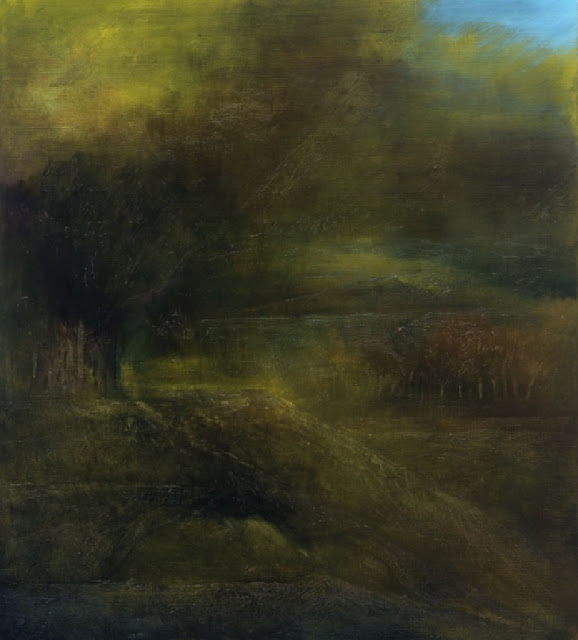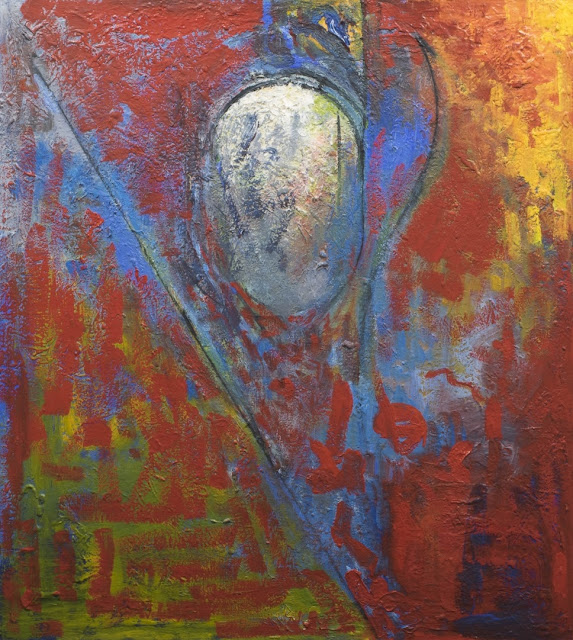"Jake Berthot (1939–2014) was an American artist whose abstract paintings contained elements of both the minimalist and expressionist styles. During the first 36 years of his career his paintings were entirely non-figurative. His style changed in 1995 when he moved his studio from New York City to a rural community in upstate New York. While continuing to be abstract his paintings thereafter contained figurative elements and were seen to have greater emotional content. Throughout his career his work frequently appeared in solo and group exhibitions in both commercial and public galleries. It has been collected by the Museum of Modern Art, Metropolitan Museum of Art, Guggenheim Museum, National Gallery of Art, and other major American art museums. He received a Guggenheim Fellowship in 1981 and a National Endowment for the Arts grant in 1983."(tate.org.uk)
"In the mid-1970s Berthot's style evolved. His work continued to have a painterly, lyrical quality, but he added bright colors to the muted palette of earlier work and introduced rectangular bars and ovals into canvases that were now simple rectangles.Regarding the bars, he later said that he worked to uncover the tension points, or focal points, that were inherent in the vertical and horizontal axes of a grid. He said he sought "a balance between the object and the opening," and thereby "to gradually achieve balance between my two influences: the systemic and the felt." "Yellow Bar With Red," of 1977 is typical of paintings in this period. Another well-known painting from this period, "Walken's Ridge," 1975-1976, is somewhat unusual. Although a pure abstraction, it has the size and shape of Monet's Water Lily paintings—14 feet wide in two equal sections— and has, as Berthot said, the feel of a landscape.During the 1980s Berthot began to exhibit etchings and drawings along with his paintings. The drawings were often graphite on a background of a gray enamel. The lines frequently formed ovoid shapes and were accompanied by quasi-calligraphic markings.A critic said this work contained a "poetic lyricism" that could be accessed "not at a cognitive level but at a more elemental, intuitive one." Berthot later told an interviewer that in it "gradually feeling began to predominate." The paintings of this period continued to employ ovals and rectangles in canvases on which the "materiality of pigment," as one critic noted, produced "a highly tactile surface."Another critic wrote that "the shimmering, encrusted surfaces of the 'ovals' are reminiscent of Claude Monet's late Waterlilies. The use of gold with deep reds and bright blues recall Medieval icons." Of his work at this time, Berthot said: "I try to break the code of painting and let it take on its own life without any code.During the early 1990s, Berthot continued to employ bars and ovals in paintings. Of this period in his career, Berthot later said, "I reached another point where the idea was closing in on itself, there was too much idea; the paintings started to feel too literal, too much like a figure in space. I wanted something more organic, more felt." He said that he wanted to "make the painting something you experience rather than just see."His "Hard Line" of 1980-83 is an early example of this approach, showing a rectangle in a muted background having bright accents that a critic said were and unexpected fiery flame. In 1994, Pepe Karmel, writing in the New York Times, said of works like these: "Despite the lack of recognizable imagery, the paintings seem haunted by a nostalgia for representation."The oval shape appears as well in Berthot's drawings and etchings of this period some of which had representational content, including most often an ovoid skull.Throughout his career, Berthot consciously kept aloof from the labeled art movements of his time. He once said, "I am not interested in the new but in trying to make paintings that refuse to grow old," and on another occasion, speaking of an affinity he felt with Cézanne's approach to his work, he said: "His clear method ... is not a closure but an opening.... You have to have a form and method and within that form and method, at a certain point you have to become the servant of the painting." Summing up this attitude on another occasion he said that as he worked a time would come when he felt that a painting would take over his consciousness "to dictate what it wanted to be." His paintings were his companions as well as the focus of his life."Wikipedia
"In the mid-1970s Berthot's style evolved. His work continued to have a painterly, lyrical quality, but he added bright colors to the muted palette of earlier work and introduced rectangular bars and ovals into canvases that were now simple rectangles.Regarding the bars, he later said that he worked to uncover the tension points, or focal points, that were inherent in the vertical and horizontal axes of a grid. He said he sought "a balance between the object and the opening," and thereby "to gradually achieve balance between my two influences: the systemic and the felt." "Yellow Bar With Red," of 1977 is typical of paintings in this period. Another well-known painting from this period, "Walken's Ridge," 1975-1976, is somewhat unusual. Although a pure abstraction, it has the size and shape of Monet's Water Lily paintings—14 feet wide in two equal sections— and has, as Berthot said, the feel of a landscape.During the 1980s Berthot began to exhibit etchings and drawings along with his paintings. The drawings were often graphite on a background of a gray enamel. The lines frequently formed ovoid shapes and were accompanied by quasi-calligraphic markings.A critic said this work contained a "poetic lyricism" that could be accessed "not at a cognitive level but at a more elemental, intuitive one." Berthot later told an interviewer that in it "gradually feeling began to predominate." The paintings of this period continued to employ ovals and rectangles in canvases on which the "materiality of pigment," as one critic noted, produced "a highly tactile surface."Another critic wrote that "the shimmering, encrusted surfaces of the 'ovals' are reminiscent of Claude Monet's late Waterlilies. The use of gold with deep reds and bright blues recall Medieval icons." Of his work at this time, Berthot said: "I try to break the code of painting and let it take on its own life without any code.During the early 1990s, Berthot continued to employ bars and ovals in paintings. Of this period in his career, Berthot later said, "I reached another point where the idea was closing in on itself, there was too much idea; the paintings started to feel too literal, too much like a figure in space. I wanted something more organic, more felt." He said that he wanted to "make the painting something you experience rather than just see."His "Hard Line" of 1980-83 is an early example of this approach, showing a rectangle in a muted background having bright accents that a critic said were and unexpected fiery flame. In 1994, Pepe Karmel, writing in the New York Times, said of works like these: "Despite the lack of recognizable imagery, the paintings seem haunted by a nostalgia for representation."The oval shape appears as well in Berthot's drawings and etchings of this period some of which had representational content, including most often an ovoid skull.Throughout his career, Berthot consciously kept aloof from the labeled art movements of his time. He once said, "I am not interested in the new but in trying to make paintings that refuse to grow old," and on another occasion, speaking of an affinity he felt with Cézanne's approach to his work, he said: "His clear method ... is not a closure but an opening.... You have to have a form and method and within that form and method, at a certain point you have to become the servant of the painting." Summing up this attitude on another occasion he said that as he worked a time would come when he felt that a painting would take over his consciousness "to dictate what it wanted to be." His paintings were his companions as well as the focus of his life."Wikipedia














No comments:
Post a Comment